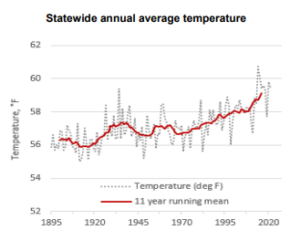A dire warning: California report documents climate impacts
By Pam Strayer
California is getting hotter and drier, and extreme weather events are increasingly disrupting the state’s natural environment and the lives of the nearly 40 million people who live there, according to a study released by state officials this week.
The 664-page report, compiled from research by more than 100 state scientists and experts, concludes that the state is experiencing a rapid decline in key indicators of ecosystem health related to climate change. The report identifies dozens of significant threats that could weaken California’s status as the fifth largest economy in the world, currently valued at $3.4 trillion.
“Across the state, we live the experience of extreme weather, deepening drought. and deadly wildfires and heatwaves,” said California Environmental Protection Agency (CalEPA) Secretary Yana Garcia. “This report shows scientifically what we know from experience.”
Among the worrisome findings is the extent to which drought is taking a hold on the state. California has been getting drier since 1895 but by the end of the 2021 water year (which began in October 2020 and ended in September 2021), drought conditions were comparable to the most severe drought period on record, according to the report.
The period from 2000 to 2021 was the driest 22-year period over the past 1,000 years for California and much of the southwestern US — what scientists refer to an emerging “megadrought” era.
Hot and getting hotter
According to the report, the state is facing an alarming warming trend that started picking up pace in the 1980s. Recent years have been especially warm, with eight of the ten warmest years on record occurring between 2012 and 2022. The year 2014 was the warmest year on record for the state.
Overall average air temperatures have increased 2.5 degrees since 1895, with nighttime temperatures increasing by almost three times more than daytime temperatures.

The heat is especially hard on outdoor laborers. Reports of work-related heat illness tripled in just the past 20 years, according to the report.
Water temperatures are also rising. The waters of Lake Tahoe have risen about 1 degree over the last 50 years, and climbed 2 degrees per decade since the mid-1990s, the report states.
And satellite readings above the seaside town of La Jolla in southern California show ocean water temperatures increasing 0.3 degrees per decade over the last 40 years.
A marine heatwave in 2014-2016 resulted in “dire ecological consequences,” the report stated, resulting in “mass strandings of marine animals and sea birds, initiation of a toxic algae bloom that led to the closure of crab fisheries, and the loss of kelp forests.”
“Gigafire”
In addition, scientists said half of the state’s largest wildfires over the past 70 years occurred in just the two most years – 2020 and 2021.
Over the last two decades, the average area burned annually by wildfires in the 2000s and the 2010s was twice the size of the area burned each year in the 1990s, according to the report. The land area burned in 2020-21 was ten times higher than an average year in the 1990s.
In 2020 the fire known as the August Complex burned more than one million acres in seven counties of the coastal range of Northern California, making it the state’s first “gigafire,” the report said.
Wildfires contributed to adverse health impacts on humans, including heat related illnesses, and health problems triggered by the particulate matter carried in smoke that can irritate the eyes, nose and lungs, and worsen chronic heart and respiratory diseases.

In addition to impacts on human health, the report notes threats to biodiversity ranging from potential food crises for Central Valley butterflies, risks to bumblebees, declining food for California sea lion pups in Santa Cruz, and peril for migratory birds that depend on California feeding grounds.
Another troubling finding from the report is evidence of the near disappearance of glaciers in the state’s Trinity Alps in northern California, and a 75% reduction in glaciers in the Sierra Nevada mountain range over the past century. As air temperatures warm, more precipitation has been falling as rain instead of snow at high elevations. Traditionally California has depended on its snowpack to store precipitation.
Overall, the report summarizes the findings with a dire warning: “California is experiencing a climate crisis that is increasingly taking a toll on the health and well-being of its people and on its unique and diverse ecosystems. Every Californian has suffered from the effects of record high temperatures, dry winters, prolonged drought, and proliferating wildfires in recent years.
“California’s biodiversity is threatened as alterations to habitat conditions brought about by a changing climate are occurring at a pace that could overwhelm the ability of plant and animal species to adapt.”




